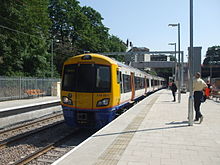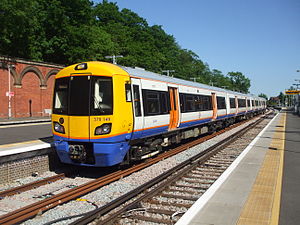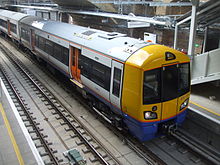- British Rail Class 378
-
British Rail Class 378 Capitalstar
London Overground Class 378 No. 378149 at Crystal Palace
The interior of a London Overground Class 378 EMUIn service 29 July 2009 – present Manufacturer Bombardier Transportation Family name Electrostar Number built 57 trainsets Formation 4 cars per set
378/1: DMSO-MSO-TSO-DMSO
378/2: DMSO-MSO-PTSO-DMSOOperator London Overground Line(s) served East London Line
North London Line
Watford DC Line
West London LineSpecifications Car length 20.4 m (66 ft 11 in) Width 2.80 m (9 ft 2 in) Height 3.78 m (12 ft 5 in) Maximum speed 75 mph (121 km/h) Weight 159.5 t (157.0 long tons) Power output 600 kW (800 hp) per driving car (3 × 200 kW motors) Electric system(s) Class 378/1: 750 V DC third rail only
Class 378/2: 750 V DC third rail / 25 kV AC overhead linesGauge 1,435 mm (4 ft 8 1⁄2 in) Standard gauge The old meets the new: 313107 and 378017 (now 4-car 378217) are seen side by side at Richmond
The Class 378 Capitalstar[1] is a type of electric multiple-unit train, part of Bombardier Transportation's Electrostar family. These trains are operating on the new London Overground network. The class is derived from the Class 376 trains used by Southeastern, with the same wider metro-style sliding pocket doors for more efficient boarding and alighting, which are faster and more reliable than plug doors, although they do not provide as much insulation for heating and cooling purposes. However, they also have significant differences from the Class 376, such as fully longitudinal seating similar to that used on London Underground rolling stock to give more standing room, needed for the high-volume metro-style services on London Overground. The units were initially announced as coming in two separate batches.
Contents
History
The deal between Bombardier and Transport for London was initially for a total of 152 individual cars costing some £223 million, with deliveries beginning in September 2008, when two trains underwent a 14-week test on the North London Line. The initial contract also contained an option to purchase additional cars up to a total of 216. A newly constructed depot near New Cross Gate station would be responsible for maintaining the new fleet.[2]
In 2006, TfL announced the new vehicles, with livery designed by Real 451 and interior concept design by Design Triangle.[3][4]
On 4 July 2007, TfL announced it had ordered a further 36 Capitalstar carriages for £36 million.[5] The order comprised three additional four-car units for the East London Line, and 24 additional carriages to extend the original 3-car units for the North London Line into 4-car units, to be delivered in 2011.[6]
In February 2008, TfL announced that the new stock would now be leased by London Overground, rather than purchased directly, from a newly formed ROSCO named QW Rail Leasing. The terms of the lease also allow for an increase in the order to 216 vehicles. In April 2008, TfL announced it had taken an option to obtain a further seven 4-car dual-voltage units, which would be delivered between 2009 and 2010, filling the full 216 vehicle option.
On 16 September 2008, the first complete unit was unveiled and began testing on Bombardier's test track before being delivered for testing on the national network.[6] Units 378201 - 217/222/225 - 231 have now been delivered to Willesden Depot.
Units 378135 - 154/218 - 221/223 - 224/232 - 234 are at New Cross Gate Depot for East London Line services. Unit 378001 was stationed at New Cross Gate Depot for testing purposes but was returned to Bombardier Transportation's Litchurch Lane Works in Derby. It has now entered service as 378201. 378004 (temporarily made up to 4 cars) was the first unit to run under power over the East London Line on 5 October 2009 and left the East London Line on 2 November 2009. 378255 - 257 are under construction and will be delivered to LOROL in 2011.
The Class 378 was originally planned to enter service in January 2009, but was delayed for seven months because of the economic recession causing several parts suppliers to become bankrupt, causing a shortage of parts for Bombardier Transportation which also affected delivery of Class 377/5 units to First Capital Connect. The first Class 378 unit entered service on 29 July 2009. On the first public unveiling of the Class 378, TfL announced that it had reached an agreement to procure a further three dual-voltage units, taking the total number to 57.[7] These units are intended to enhance the fleet once the South London Line is brought under London Overground's control.
The trains cannot be used on the Gospel Oak to Barking Line, as it is not electrified. Although electrification of the line is a long-term aim, it is not included in the short- or medium-term plans of either TfL or Network Rail. As a consequence, TfL also ordered eight Class 172 Turbostar units for use on that line.
In 2011, several 378s on the North London Line suffered shutdowns due to harmonic interference from Class 92s using the line for freight movement. The problem was fixed after LOROL altered the interference tolerance settings.[8]
Features and fitted equipment
 A London Overground Class 378 at Willesden Junction
A London Overground Class 378 at Willesden Junction
Innovations for the passenger are air-conditioning, real-time passenger information systems, wheelchair access, the ability for level access, and different seat moquette colours to highlight priority seating.[6]
There are wide gangways between cars, giving a feel similar to an articulated bus.
In addition to the usual two-tone horn, Class 378 units are also fitted with a soft two-tone horn and a London-Underground-type kettle whistle (referred to as a depot whistle). A tripcock device is also installed as on the existing London Overground Class 313 stock. The tripcock is the London Underground failsafe equivalent of the Train Protection & Warning System used on the National Rail network.
External CCTV is displayed automatically on releasing the doors via an in-cab monitor, removing the need for Driver-Only Operation (DOO) equipment such as monitors/mirrors at platforms. This is similar to that already used on Southern's Electrostar units.
Internal CCTV footage can be viewed directly by the driver on an in-cab monitor, so that he or she may immediately view the affected area of the train (in addition to speaking to the person) if a passenger operates the passenger alarm.
The driver has the option of releasing the doors so that passengers can use individual door buttons to open as required. The driver can also release and open all the doors on one side, in a similar fashion to tube trains, but this option is not used in passenger service and is only intended for evacuation purposes.[citation needed]
The units are fitted with three radio systems: National Radio Network, which is used over the western section of the North London Line; Cab Secure Radio, used over the Watford DC route, the West London line and beyond New Cross on the South London line; and GSM-R, used on the eastern section of the North London Line and the East London Line between Dalston and New Cross. 378/1 units are equipped only with GSM-R and CSR radio, as they are not intended to operate over routes equipped with NRN only.
Class 378 suppliers
A Bombardier Class 378 Capitalstar EMU No. 378137 at Whitechapel on a East London Line service
The Class 378 has been built by a number of worldwide suppliers:[citation needed]
- Main contractor = Bombardier, Derby
- Traction motors = Bombardier, Sweden
- Bogies = Bombardier, Germany
- Air conditioning = Liebherr, Germany
- Interior panelling = Gilberts, Blackpool & KTK, China
- Cabling = Time 24, Derby; Simclar Scotland
- Brake Control = Knorr Bremse, Melksham
- Friction Brake and Actuation = Faiveley Transport
- Door mechanisms = IFE, Austria (Knorr Bremse)
- Batteries = Saft, France
- Seats = Kiel, Germany
- Passenger Information System = Whiteley, UK
- Couplers = Dellner, Sweden
- CCTV = March Networks, Canada
- Gangways = Hübner, Germany
- Shoegear and Pantograph = Brecknell Willis, UK
- Shock absorbers = ZF Sachs, Germany
Fleet
 Class 378 No. 378005 stands at Canonbury on a North London Line service while still a 3-car 378/0. It has since been renumbered 378205 upon addition of a fourth car.
Class 378 No. 378005 stands at Canonbury on a North London Line service while still a 3-car 378/0. It has since been renumbered 378205 upon addition of a fourth car. London Overground class 378 arriving at Richmond station.
London Overground class 378 arriving at Richmond station.
The Class 378 fleet is currently formed of two separate subclasses, DC-only 378/1 and dual-voltage (AC and DC) Class 378/2:
- Class 378/1 (East London Line) - 20 four-car units were ordered. These units operate services on the extended East London Line, and are 750V DC only. These trains, which are designated Class 378/1, replaced the A60/A62 Stock previously used on the line. They entered service on 27 April 2010, on the preview service between Dalston Junction and New Cross / New Cross Gate. The service was extended to Crystal Palace and West Croydon on 23 May 2010. In common with all trains in the Electrostar family, these DC-only units have a recessed roof space for the fitting of a pantograph and other equipment for dual-voltage working in the future if necessary.
- Class 378/2 (North London Line, West London Line, Watford DC Line) - 37 dual-voltage four-car units ordered for the North London, West London, East London and Watford DC lines. These units will have dual-voltage capability, taking current at 25kV AC from overhead wires or 750 V DC from third rail. These trains replaced the Class 313 units in 2010. The first 24 units were originally three-car units designated Class 378/0 (378001-378024), and were were redesignated 378/2 (renumbered 378201-378224) as each unit received its additional carriage in late 2010. The remaining 13 units (of which 378225 was the first) were built as four-car Class 378/2s from the outset.
Class Operator No. Built Year Built Cars per Set Unit nos. Notes Class 378/1 London Overground 20 2009–2010 4 378135–378154 Third-rail only Class 378/2 24 2008–2010 378201–378224 Originally built as 3-car Class 378/0 (378001–378024) 13 2010–2011 378225–378234
378255–378257See also
- London Overground
- Class 313
References
- ^ Pritchard, R. (November 2008). "TfL's first Class 378 ready to roll!". Today's Railways UK (Sheffield): p. 32.
- ^ "Bombardier Wins A £223 Million Order From Transport For London For 152 Electric Multiple Unit Cars For The United Kingdom" (Press release). Bombardier Transportation. 31 August 2006. http://bombardier.com/en/corporate/media-centre/press-releases/details?docID=0901260d8000f75c.
- ^ http://www.mad.co.uk/Main/Home/Articles/ac6c887ea949489ba83a01c7b566349b/TfL-design-teams-develop-London-Overground-service.html
- ^ http://www.mad.co.uk/Main/News/Sectors/Travel/Transport/Articles/725e3bd9c28d4763b481f053ef260e2a/Going-overground.html
- ^ "£36m contract to bring extra rail carriages for London Overground" (Press release). Transport for London. 4 July 2007. http://www.tfl.gov.uk/static/corporate/media/newscentre/archive/5432.html.
- ^ a b c "New London Overground Class 378s take shape at Derby". Railway Herald (Scunthorpe): p. 4,5. 22 September 2008. http://www.railwayherald.co.uk/magazine/pdf/RHUK/Issue148HIGH.pdf.
- ^ Morrison, Brian (August 2009). "Mayor rides Class 378 - TfL orders three more". Modern Railways (London): p. 8.
- ^ "Class 92 shuts down 378s - solution found". Modern Railways (London) (750): p. 9. March 2011.
External links
Bombardier Turbostar and Electrostar family Turbostar family: Electrostar family: London Overground Current routes Anerley · Brockley
· Brockley  · Canada Water
· Canada Water  · Canonbury · Crystal Palace
· Canonbury · Crystal Palace  · Dalston Junction · Forest Hill
· Dalston Junction · Forest Hill  · Haggerston · Highbury & Islington
· Haggerston · Highbury & Islington 
 · Honor Oak Park
· Honor Oak Park  · Hoxton · New Cross
· Hoxton · New Cross  · New Cross Gate
· New Cross Gate  · Norwood Junction
· Norwood Junction  · Penge West
· Penge West  · Rotherhithe · Shadwell
· Rotherhithe · Shadwell  · Shoreditch High Street · Surrey Quays · Sydenham
· Shoreditch High Street · Surrey Quays · Sydenham  · Wapping · West Croydon
· Wapping · West Croydon 
 ·
·
Whitechapel Acton Central · Brondesbury · Brondesbury Park · Caledonian Road & Barnsbury · Camden Road · Canonbury · Dalston Kingsland · Finchley Road & Frognal · Gospel Oak · Gunnersbury
Acton Central · Brondesbury · Brondesbury Park · Caledonian Road & Barnsbury · Camden Road · Canonbury · Dalston Kingsland · Finchley Road & Frognal · Gospel Oak · Gunnersbury · Hackney Central · Hackney Wick · Hampstead Heath · Highbury & Islington
· Hackney Central · Hackney Wick · Hampstead Heath · Highbury & Islington 
 · Homerton · Kensal Rise · Kentish Town West · Kew Gardens
· Homerton · Kensal Rise · Kentish Town West · Kew Gardens  · Richmond
· Richmond 
 · South Acton ·
· South Acton ·
Stratford

 · West Hampstead
· West Hampstead 
 · Willesden Junction
· Willesden Junction  Bushey
Bushey · Carpenders Park · London Euston
· Carpenders Park · London Euston 
 · Harlesden
· Harlesden  · Harrow & Wealdstone
· Harrow & Wealdstone 
 · Hatch End · Headstone Lane · Kensal Green
· Hatch End · Headstone Lane · Kensal Green  · Kenton
· Kenton  · Kilburn High Road · North Wembley
· Kilburn High Road · North Wembley  · Queen's Park
· Queen's Park  · South Hampstead · South Kenton
· South Hampstead · South Kenton  · Stonebridge Park
· Stonebridge Park  · Watford High Street · Watford Junction
· Watford High Street · Watford Junction  · Wembley Central
· Wembley Central 
 · Willesden Junction
· Willesden Junction  Clapham Junction
Clapham Junction · Imperial Wharf
· Imperial Wharf  · Kensington (Olympia)
· Kensington (Olympia) 
 · Shepherd's Bush
· Shepherd's Bush 
 · West Brompton
· West Brompton 
 · Willesden Junction
· Willesden Junction 
Future phases South London LineProposed stationsRolling stock Class 172 · Class 378Former rolling stock Operations History Transport for London
Categories:- British Rail electric multiple units
- Bombardier multiple units
- London Overground
Wikimedia Foundation. 2010.




